Mass Spectrometry & Spectroscopy
How Many Cannabinoids Are Identified?
Mar 22 2022
Humans have been harnessing the powerful medicinal properties of the Cannabis sativa plant for centuries. Since British chemist Robert S. Cahn discovered the first individual cannabinoid in the 1940s, scientists have been fascinated with isolating and identifying these unique compounds. To date, more than 100 cannabinoids have been identified, some abundant in the Cannabis sativa plant and others more elusive.
Read on to find out more about some of the most important cannabinoids that have been identified over the decades:
THC
Delta-9-tetrahydrocannabinol (THC) is the key psychoactive component of cannabis and as a result, receives a plethora of attention. While coveted by recreational cannabis users, the “head highs” associated with THC make it unsuitable for medical cannabis, at least in high concentrations.
That said, attitudes towards THC have been changing, with a government-approved US study recently finding the cannabinoid useful for treating PTSD.
“This study served as the first randomized placebo-controlled trial comparing the therapeutic potential of varying ratios of THC and CBD for treating symptoms of PTS,” said lead author of the study, Dr. Marcel O. Bonn-Miller. “It would help determine the minimally-effective doses of THC needed to safely treat individuals suffering from PTSD,” Bonn-Miller said. “It will also mitigate risks of cannabis dependence in this vulnerable population.”
CBD
Cannabidiol (CBD) is another widely recognised cannabinoid. Its anti-inflammatory properties make it highly sought-after by medical cannabis manufacturers. As well as relieving pain and inflammation, CBD is used to treat anxiety, depression and other neurological disorders.
CBN
While Cannabinol (CBN) is derived from THC, it’s nowhere near as potent. The non-psychoactive cannabinoid has been studied for its sedative properties, with scientists exploring it as a sleep aid for conditions such as insomnia. Other studies have positioned it as a potential treatment for relieving joint and muscle pain.
CBG
Cannabigerol (CBG) has made big waves in the medical cannabis industry, with scientists exploring its potential as a pain reliever and sleep regulator. The cannabinoid is derived from Cannabigerolic acid (CBGA), which is often referred to as the “mothership” of cannabinoids. This is because all cannabinoids, including THC and CBD, are derived from CBGA. As the decarboxylated form of the “mothership” cannabinoid, it’s no surprise CBG has captured the attention of scientists.
The complexity of the Cannabis sativa matrix, coupled with the strict rules and regulations surrounding medical marijuana, have forced scientists to develop advanced methods for analysing the plant. Find out more about the rapidly growing industry, including the different methods used to detect and quantify cannabinoids in ‘Medical Cannabis - Testing, Analysis & Identification’.
Digital Edition
ILM 49.5 July
July 2024
Chromatography Articles - Understanding PFAS: Analysis and Implications Mass Spectrometry & Spectroscopy Articles - MS detection of Alzheimer’s blood-based biomarkers LIMS - Essent...
View all digital editions
Events
Jul 28 2024 San Diego, CA USA
Jul 30 2024 Jakarta, Indonesia
Jul 31 2024 Chengdu, China
ACS National Meeting - Fall 2024
Aug 18 2024 Denver, CO, USA
Aug 25 2024 Copenhagen, Denmark



.jpg)
24_06.jpg)













